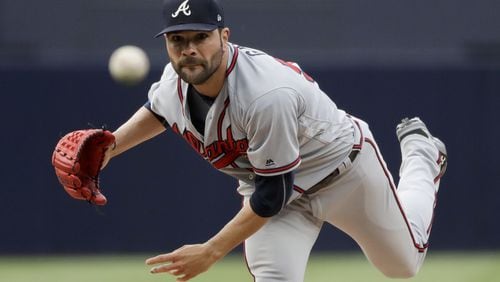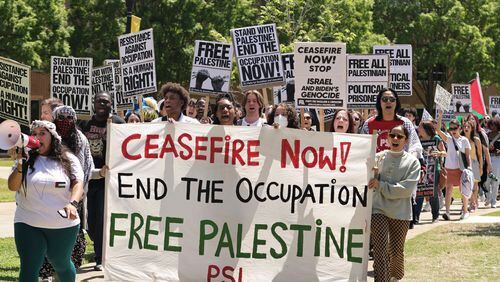The Braves haven’t just defied all dire predictions since Freddie Freeman fractured his wrist May 17, they’ve actually posted a better record and similar offense without their best player than they did before he got hurt.
Now comes the tricky part.
They’ve have won 16 of 25 games to get within one win of .500 (40-41) at the season’s midpoint, but now face the most difficult part of the schedule at a time when decisions loom as the July 31 non-waiver trade deadline approaches.
Oh, and Freeman should be back in the lineup either in a road series at Washington that starts Thursday or a week later immediately after the All-Star break.
The Braves, after a thrilling three-game sweep at Oakland, were off Monday before hosting two games against an Astros team that has baseball’s best record, then traveling to D.C. for a four-game series starting Thursday against the National League East-leading Nationals that takes them to the All-Star break.
Coming out of the break, it only gets more difficult: the Braves have a six-game homestand against the Diamondbacks, who have the NL’s second-best record, and the defending World Series champion Cubs, then go on a three-city trip that begins with four games against the Dodgers (NL’s best record) and three at Arizona.
“We have a tough stretch coming, but it’s exciting to see what could happen,” Braves general manager John Coppolella said. “We search every day to make this team better for the short- and long-term.”
So, will the Braves be buyers or sellers before the trade deadline? They won’t divulge plans, but this observer’s answer to that question is yes.
That’s not meant to be vague or to avoid the question; I think there’s a good chance they’ll be both buyers and sellers between now and July 31. Because while the Braves rebuilding project continues, they already passed the point in the rebuild where they write off the present just to get better years from now. They turned that corner last offseason.
The Braves wanted to be competitive in front of the larger crowds they expected in their first season at new SunTrust Park, and they’ve done that, especially lately. Now that they’re flirting with .500 and have much of their fan base feeling better about the direction of the team, the Braves are cognizant of the fact that a strip-down before the trade deadline, selling off every veteran for whatever they can get, is neither a good business decision – they don’t want to tank the rest of the season at SunTrust – or good for morale in the clubhouse, the team’s offices, or throughout Braves Country.
They want to win, and they can do that the rest of the way without trading every veteran not under a long-term deal.
Most likely to be dealt is left-hander Jaime Garcia, though his trade value has surely dipped with three consecutive bad starts that raised his ERA from 3.16 to 4.35 and his homers-allowed total from seven through his first 12 starts to 12 through 15 starts. Still, Garcia is in the final year of his contract and the Braves aren’t going to re-sign him, so they need to get what they can before the deadline and replace him with one of their own young pitchers or … a trade acquisition.
Yes, this is what is meant by the Braves could be buyers and sellers. Because while they are likely to trade Garcia, they would like to trade for a frontline starter under contractual control for multiple seasons. The primary trio in that group are Tampa Bay’s Chris Archer, White Sox All-Star lefty Jose Quintana and Oakland’s Sonny Gray.
With several contending teams known to have interest in one or more of those pitchers, the price for each will be steep in terms of young talent demanded in a deal. But the Braves have stockpiled plenty of prospects, particularly a bevy of pitchers, and have said all along that not all of those prospects would end up in Atlanta, that some of them would be used as currency to fill immediate needs. Archer, Quintana or Gray could be the first to warrant using some of that currency.
The Braves also have second baseman Brandon Phillips in the final year of his contract. While it seemed certain when they traded for Phillips just before spring training that he’d be dealt by the end of July, that’s no longer a given.
The outgoing veteran been such a productive player and such a good influence on rookie shortstop Dansby Swanson and clubhouse chemistry in general, the Braves could opt to keep Phillips for the rest of the season and let Ozzie Albies continue to get minor league seasoning at Triple-A, where the switch-hitting prospect has been working with Braves special assistant Chipper Jones and Gwinnett staff to revamp his left-handed swing.
And of course there’s the situation at first base: The Braves traded for Matt Adams to serve as a fill-in while Freeman was on the DL, but Adams has been such an offensive force that the Braves are ready to let Freeman play third base – it was Freeman’s idea – on a temporary basis in order to keep Adams in the lineup rather than move his power bat to the bench.
Still, despite Freeman playing third on his rehab assignment and expected to be at third when he comes off the DL, the Braves sould be overwhelmed by a trade offer for Adams before July 31, something too good to pass up, especially since rookie Johan Camargo has played so well filling in for injured third baseman Adonis Garcia.
Moving Freeman back to first base and leaving Camargo at third would give the Braves much better defense than they would have with Freeman at third for the first time since rookie ball and Adams’ just-serviceable glove at first base.
The Braves could trade closer Jim Johnson, who has a year left on his contract and will draw trade interest on a landscape with so many contending teams concerned about their shaky bullpens. But that decision probably isn’t an easy one either for the Braves, who would risk putting a hole in their own improved bullpen for the second half and removing a veteran whose leadership has been valuable among young relievers and other bullplen newcomers.
Perhaps the Braves will decide to sell high on the likes of still relatively young reliever Arodys Vizcaino, since they have others including A.J. Minter who are close to being ready.
Lots of decisions ahead, and not until the end of July is there a breather in the schedule – a four-game series at Philadelphia July 28-31. Then it’s another three-game series against the Dodgers.
The point being, the Braves have played a rousing brand of baseball to get themselves back at least on the periphery of the playoff discussion, but the next few weeks will show if they are presently constructed to remain near .500 through summer.
By the way, manager Brian Snitker has his team at two games over .500 for 178 games going back to June 15, 2016, despite the Braves being out-homered 212-176 and outscored 871-818 in that stretch. That’s a reflection of what they do best: Win close games.
The Braves can look ugly when they lose, but most nights they are in games till the end and win more than their share of the really close ones.
The players point to their clubhouse chemistry as a big part of their success. Don’t think that’s not something the front office considers as the trade deadline nears.
About the Author






